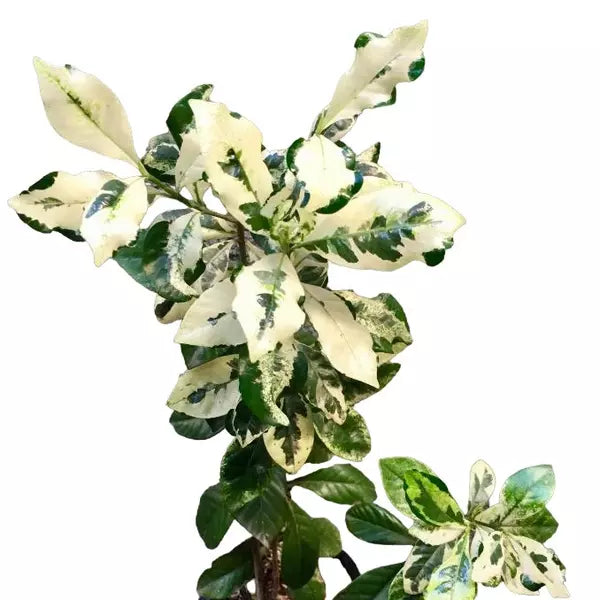
Gardenia Jasminoides 'Variegated' - Rare
Sellling size: Last Picture| Pot Included
CLASSIFICATIONS AND CHARACTERISTICS
Plant Division
Angiosperms (Flowering Seed Plants) (Dicotyledon)
Plant Growth Form
Shrub
Lifespan (in Singapore)
Perennial
Mode of Nutrition
Autotrophic
Plant Shape
Shrubby
BIOGEOGRAPHY
Native Habitat
Terrestrial
Preferred Climate Zone
Tropical
DESCRIPTION AND ETHNOBOTANY
Growth Form
Large, woody evergreen shrub with a dense, rounded crown, able to grow up to 2.5 m tall.
Foliage
Glossy, deeply veined leaves are elliptic with entire leaf margin. Variegated leaves are dark green along the midrib with an irregular cream to white border along the leaf margin.
Flowers
Fragrant, double flowers are white to creamy white, about 7 cm wide.
Cultivation
This species has a slow growth rate. It blooms best in full sun, but also tolerates partial shade. It grows best in well-draining soils that are acidic (pH 5.5 - 6) and rich in compost. Mulch the plants with compost to prevent the soil from drying out or the roots from overheating. Feed plants with a palm fertilizer 3 times a year and prune after flowering.
Etymology
Genus "Gardenia" is named after Dr. Alexander Garden, an American doctor who also studied plants and animals (1730 - 1791). The species epithet "jasminoides" means similar to Jasmine, referring to the species's Jasmine-like fragrance.
LANDSCAPING FEATURES
Landscaping
This free-flowering species is grown for its large, fragrant flowers and variegated leaves. The variegated leaves provide a contrast in colour next to green foliage plants and help to brighten partly shady areas. It is suitable for container plantings and makes an attractive specimen plant. Avoid planting several types of fragrant flowering shrubs together or too many of them together as the aromas could clash or become too strong.
Desirable Plant Features
Ornamental Flowers, Fragrant (Flowers), Ornamental Foliage
Plant Rootzone Preference - Tolerance
Moist Soils, Well-Drained Soils
Landscape Uses
Parks Gardens, Small Gardens, Flowerbed / Border, Container Planting
Thematic Landscaping
Fragrant / Aromatherapy Garden
FAUNA, POLLINATION AND DISPERSAL
Fauna Pollination Dispersal Associated Fauna
Butterfly Food Plant
Pollination Method(s)
Biotic (Fauna)
PLANT CARE AND PROPAGATION
Light Preference
Full Sun
Water Preference
Moderate Water
Propagation Method
Stem Cutting
FOLIAR
Foliage Retention
Evergreen
Mature Foliage Colour(s)
Green, White
Mature Foliage Texture(s)
Glossy / Shiny
Prominent Young Flush Colour(s)
Green, White
Young Flush Texture(s)
Glossy / Shiny
Foliar Modification
Stipule
Foliar Type
Simple / Unifoliate
Foliar Arrangement Along Stem
Opposite
Foliar Attachment to Stem
Petiolate
Foliar Shape(s)
Non-Palm Foliage
Foliar Venation
Pinnate / Net
Foliar Margin
Entire - Wavy / Undulate
Foliar Apex - Tip
Acute
Foliar Base
Acute
Leaf Area Index (LAI) for Green Plot Ratio
4.5 (Shrub Groundcover - Dicot)
FLORAL (ANGIOSPERM)
Flower Plant Sexuality 1
Bisexual Flowers
Flower Colour(s)
White
Flower Texture(s)
Smooth
Flower Grouping
Solitary
Flower Location
Terminal
Flower Symmetry
Radial
Individual Flower Shape
Tubular
Flowering Period
Free-Flowering

